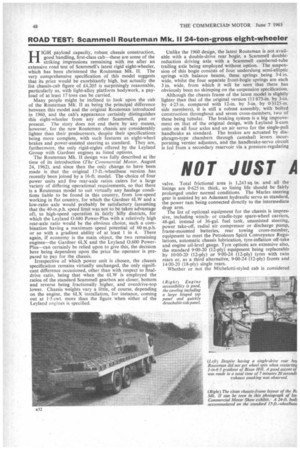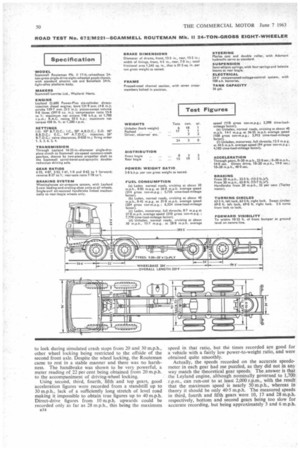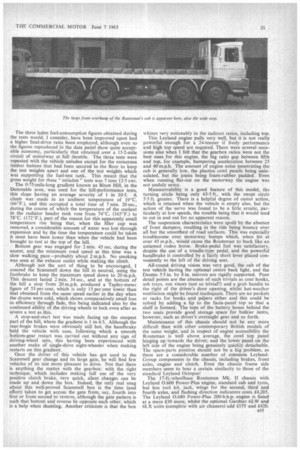NOT JUST A ?ETTY FACE
Page 50

Page 51

Page 52

Page 53

If you've noticed an error in this article please click here to report it so we can fix it.
HIGH payload capacity, robust chassis construction, good handling, first-class cab—these are some of the striking impressions remaining with me after an extensive road test of Scammell's latest rigid eight-wheeler, which has been christened the Routeman Mk. 11. The very comprehensive specification of this model suggests that its price would be exorbitantly high, but actually the list chassis-cab figure of £4,205 is surprisingly reasonable, particularly as, with light-alloy platform bodywork, a payload of at least 17 tons can be carried_
Many people might be inclined to look upon the cab of the Routeman Mk. 11 as being the principal difference between this model and the original Routeman introduced in 1960, and the cab's appearance certainly distinguishes this eight-wheeler from any other Scammell, past or present. The story does not end there by any means, however, for the new Routeman chassis are considerably lighter than their predecessors, despite their Specifications being more complete, with such features as eight-wheel brakes and power-assisted steering as standard. They are, furthermore, the only rigid-eights offered by the Leyland Group with Gardner engines as listed options.
The Routeman Mk. II design was fully described at the time of its introduction (The Commercial Motor. August 24, 1962), and since then the only change to have been made is that the original 17-ft.-wheelbase version has recently been joined by a I6-ft. model. The choice of four power units and five rear-axle ratios caters for a large variety of differing operational requirements, so that there is a Routeman model to suit virtually any haulage conditions liable to be found in this country, from low-speed working in flat country, for which the Gardner 6LW and a low-ratio axle would probably be satisfactory (assuming that the 40-m.p.h. speed limit was not to be taken advantage of), to high-speed operation in fairly hilly districts, for which the Leyland 0.680 Power-Plus with a relatively high rear-axle ratio would be the obvious choice, such a combination having a maximum speed potential of 60 m.p.h. or so with a gradient ability of at least 1 in 4. There again, if economy is the main object, the two remaining engines—the Gardner 6LX and the Leyland 0.600 PowerPlus—can certainly be relied upon to give this, the decision here being dependent upon the price the operator is prepared to pay for the chassis.
Irrespective of which power unit is chosen, the chassis specification remains virtually unchanged, the only significant difference occasioned, other than with respect to finaldrive ratio, being that when the 6LW is employed the ratios of the standard Scammell gearbox are closer, bottom and reverse being fractionally higher, and overdrive-top lower. Chassis weights vary a little, of course, depending on the engine, the 6LX installation, for instance, coming out at 1.5 cwt. more than the figure when either of the Leyland engines is specified. Unlike the 1960 design, the latest Routeman is not available with a double-drive rear bogie, a Scammell doublereduction driving axle with a Scammell cambered-tube trailing axle being employed without option. The suspension of this bogie consists of four underslung semi-elliptic springs with balance beams, these springs being 3-4 in. wide, whilst the four separate front-bogie springs are each 3 in. wide, from which it will be seen that there has obviously been no skimping on the suspension specification.
Although the chassis frame of the latest model is slightly lighter than that of the original version (11.875-in. by 3-in. by 4.25 in. compared with 12-in. by 3-in. by 0.3125-in. side members), it is still a robust assembly, with bolted construction throughout and seven cross-members, two of these being tubular. The braking system is a big improvement on that of the original design, with Leyland S-cam units on all four axles and an air servo for the single-pull handbrake as standard. The brakes are actuated by diaphragm-type chambers through camshaft levers incorporating vernier adjusters, and the handbrake-servo circuit is fed from a secondary reservoir via a pressure-regulating
valve. Total frictional area is 1,243 sq. in. and all the linings are 0.625 in. thick, so lining life should be fairly prolonged under normal conditions. The Marles steering gear is assisted by an Adamant hydraulic servo as standard, the power ram being connected directly to the intermediate drop arm, • The list of optional equipment for the chassis is impressive, including winchor cradle-type spare-wheel carriers, 48-gal. instead of 36-gal. fuel tank, unassisted steering, power take-off, radial air compressor or discharge pump, frame-mounted batteries, rear towing cross-member, equipment to meet the Petroleum Spirit Conveyance Regulations, automatic chassis lubrication, tyre-inflation off-take and engine oil-level gauge. Tyre options are extensive also, the standard 9.00-20 (12-ply) equipment being replaceable by 10.00-20 (12-ply) or 9-00-24 (12-ply) tyres with twin rears or, as a third alternative, 9.00-24 (12-ply) fronts and 14-00-20 (18-ply) single rears. Whether or not the Michelotti-styled cab is considered very attractive is a matter of personal taste—for myself, I found the appearance grew on me—but there is no doubt about the Scammell designers having developed a very good layout within the shell-shape conceived by the Italian stylist. Furthermore, the cab is a well-made and wellfinished assembly, credit for which is due to the manufacturers, Malcolm Thomas (Plastics) Ltd., Alperton, Middlesex. One of the big advantages of the cab—easy access—stems from the use of a set-back front-bogie layout for the chassis, this obviously having arisen from the desire to make this chassis suitable for operation at 28 tons gross weight, for which it is necessary to get as high a frontbogie loading as possible.
As a result, less than 10 in. of the cab extends behind the centre line of the leading axle, whilst the cab shell itself is just under 64 in. long, although this does not imply restricted interior space, as its overall width is 8 ft. Lightness is another asset of this Thomas assembly, the cab, complete with seats, batteries and electrical controls weighing little more than 8.5 cwt.
Because the majority of the cab is ahead of the front wheels, the floor layout is uncluttered, and there is no step-down between the door sill and the floor. The sill height, incidentally, is only a couple of inches or so above the frame height, whilst the step in the lower skirt panel is about 18 in. below this, or approximately 21t. above ground level. Despite a wide engine cowl, there is plenty of room for driver and mate, and the engine cowl itself is so designed as to offer maximum accessibility to all parts of the unit with the minimum of panel removal. The Routeman Mk, II made available to me for test was a 17-ft.-wheelbase model with Leyland 0.600 PowerPlus engine and 7.78-to-1 axle, the dry chassis-cab weight of which is quoted as 5 tons 11 cwt. Mounted on it was a Bonallack light-alloy platform body with 24-ft. 2375-in.long floor space and a headboard extending to the level of the cab roof, the body weight being 10-5 cwt. The flooring was of Dekaloy interlocking ribbed sections and the 3-in. by 2-in, by 0-25-in, headboard framing was panelled with 14-gauge alloy sheet, the headboard assembly being braced to the side rails with 10-gauge gussets.
Ready for the road, the kerb weight of the complete vehicle came to 6 tons 18.25 cwt., this figure including a spare wheel in a completely inaccessible carrier tucked under the rear end of the chassis frame. Iron test weights were the payload, these being evenly distributed over the body floor (with the exception of two large blocks at the rear of the body). With Dick Batten of Scammell and myself aboard the gross weight for the tests was 24 tons 3 cwt., the inter-bogie distribution being such that, with the cab empty, both bogies were almost equally laden, although in each case the leading axles were bearing more weight than the others, the difference in the case of the rear bogie being 14.25 cwt. Braking tests produced rather disappointing figures, which I put down principally to the relatively light rearbogie loading which was permitting all the rear wheek B33 to lock during simulated crash stops from 20 and 30 m.p.h., other wheel locking being restricted to the offside of the second front axle. Despite the wheel locking, the Routeman came to rest in a stable manner and there was no harshness. The handbrake was shown to be very powerful, a meter reading of 22 per cent being obtained from 20 m.p.h. to the accompaniment of driving-wheel locking.
Using second, third, fourth, fifth and top gears, good acceleration figures were recorded from a standstill up to 30 m.p.h., lack of a sufficiently long stretch of level road making it impossible to obtain true figures up to 40 m.p.h. Direct-drive figures from 10 m.p.h. upwards could be recorded only as far as 28 m.p.h., this being the maximum
834
speed in that ratio, but the times recorded are good for a vehicle with a fairly low power-to-weight ratio, and were obtained quite smoothly.
Actually, the speeds recorded on the accurate speedometer in each gear had me puzzled, as they did not in any way match the theoretical gear speeds. The answer is that the Leyland engine, although nominally governed to 1,700 r.p.m., can run-out to at least 2,000 r.p.m., with the result that the maximum speed is nearly 50 m.p.h., whereas in theory it should be only 40-5 m.p.h. The measured speeds in third, fourth and fifth gears were 10, 17 and 28 m.p.h. respectively, bottom and second gears being too slow for accurate recording, but being approximately 3 and 6 m.p.h.
The three laden fuel-consumption figures obtained during the tests would, I consider, have been improved upon had a higher final-drive ratio been employed, although even so the figures reproduced in the data panel show quite acceptable economy, particularly that obtained over a 15.2-mile circuit of motorway at full throttle. The three tests were repeated with the vehicle unladen except for the numerous timber battens that had been secured to the floor to keep the test weights apart and one of the test weights which was supporting the fuel-test tank. This meant that the gross weight for these " unladen " tests was 7 tons 12.5 cwt.
The 075-mile-long gradient known as Bison Hill, in the Dunstable area, was used for the hill-performance tests, this slope having an average severity of 1 in 10-5. A climb was made in an ambient temperature of 19°C. (66°F.), and this occupied a total time of 7 min. 20 sec., during the course of which the temperature of the coolant in the radiator header tank rose from 74°C. (165°F.) to 78°C. (172°F.), part of the reason for this apparently. small temperature rise being that, when the filler cap was removed, a considerable amount of water was lost through expansion and by the time the temperature could be taken it must have been lower than when the vehicle had been brought to rest at the top of the hill.
Bottom gear was engaged for 2 min. 45 sec. during the ascent, and the minimum road speed at this time was a slow walking pace—probably about 2 m.p.h. No smoking was seen at the exhaust outlet while making the climb. Although not the sort of thing to be encouraged. I coasted the Scammell down the hill in neutral, using the footbrake to keep the maximum speed down to 20 m.p.h. This descent lasted 2 min. 34 sec., and at the bottom of the hill a stop from 20 m.p.h. produced a Tapley-meter figure of 53 per cent, which is only 15 per cent lower than that obtained from the same speed earlier in the day when the drums were cold, which shows comparatively small loss in efficiency through fade, this being indicated also by the continued ability of the driving wheels to lock even after as severe a test as this.
A stop-and-start test was made facing up the steepest part of the hill, where the gradient is 1 in 6.5. Although the rear-bogie brakes were obviously still hot, the handbrake held the vehicle with ease, following which a smooth bottom-gear restart was carried out without any sign of driving-wheel spin, this having been experienced with another make of single-drive eight-wheeler when making restarts on this gradient.
Once the driver of this vehicle has got used to the Scammell gear change and its large gate, he will find few vehicles of its size more pleasant to drive. Not that there is anything the matter with the gearbox: with the right technique, which includes making full use of the very positive clutch brake, very quick, silent changes can be made up and down the box. Indeed, the only real snag about this well-proved Scammell box is the time (and effort) taken to get across the gate from, say, fourth into first or from second to reverse, although the gate pattern is such that bottom and reverse lie opposite each other, which is a help when shunting. Another criticism is that the box whines very noticeably in the indirect ratios, including top. This Leyland engine pulls very well, but it is not really powerful enough for 24-tonner if lively performance and high top speed are required. There were several occasions also when I felt that the gearbox ratios were not the best ones for this engine, the big ratio gap between fifth and top, for example, hampering acceleration between 25 and 40 m.p.h. The amount of engine noise penetrating the cab is generally low, the plastics cowl panels being uninsulated, but the joints being foam-rubber padded. Even when running flat-out on the motorway the engine was not unduly noisy.
Manceuvrability is a good feature of this model, the turning circle being only 63.5 ft., with the swept circle 5.5 ft. greater. There is a helpful degree of castor action, which is retained when the vehicle is empty also, but the action of the 'servo was found to be a little erratic, particularly at low speeds, the trouble being that it would tend to cut in and out for no apparent reason.
The suspension characteristics were spoilt by the absence of front dampers, resulting in the ride being bouncy over all but the smoothest of road surfaces. This was especially troublesome over motorway bumps which, when hit at over 45 m.p.h., would cause the Routeman to buck like an untamed rodeo horse. Brake-pedal feel was satisfactory, despite the use of a treadle-type pedal, and the powerful handbrake is controlled by a fairly short lever placed conveniently to the left of the driving seat.
All-round driving vision was very good, the cab of the test vehicle having the optional centre back light, and the Desmo 5-5 in. by 8 in. mirrors are rigidly supported. Poor detail points are the absence of such trivials as coat hooks, ash trays, sun visors (not so trivial?) and a grab handle to the right of the driver's door opening, whilst hot-weather ventilation might be found inadequate. There are no pockets or racks for books and pdpers either and this could be solved by adding a lip to the facia-panel top so that a shelf is formed. The tops of the battery boxes behind the two seats provide good storage space for bulkier items, however, such as driver's overnight gear and so forth.
Maintenance of this chassis should not be any more difficult than with other contemporary British models of the same weight, and in respect of engine accessibility the Routeman is well above average, the cowl top panel hinging up towards the driver, and the lower panel on the left side of the engine being genuinely quickly detachable. The spare-parts position should not be a big problem, as there are a considerable number of common LeylandGroup components in the chassis, including brakes, front axles, engine and clutch. Even the chassis frame side members seem to bear a certain similarity to those of the standard Leyland Octopus! The 17-ft.-wheelbase Routeman Mk. II chassis with Leyland 0.600 Power-Plus engine, standard cab and tyres, but less tool kit, jack, wings for the second, third and fourth axles, and flashing direction indicators costs £4,205. The Leyland 0.680 Power-Plus 200-b.h.p. engine is listed at a mere £30 more, whilst the optional Gardner 6LW and 6LX units (complete with air cleaners) add £175 and £420.




































































































